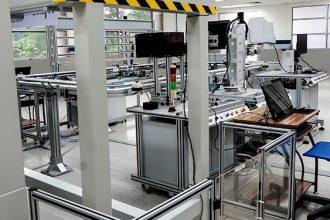5 Key Steps To Create A Culture Focused On Worker Ergonomics, Safety

Technology and automation are changing the landscape of manual material handling. However, these tasks still require repetitive movement and physical activity. That’s why it’s all the more important to put a significant focus on ergonomics and worker safety, elevating it to becoming a key aspect of company culture.
But if it’s not already an embedded philosophy, how do you put worker wellbeing at the heart of your operation? Use the following blueprint to prioritize worker safety and ergonomics within your material handling processes.
Step 1: Observe
The best way to implement a strategy that positively impacts worker wellbeing is to ask the workers themselves about their concerns. Talk to workers, supervisors, and managers about where problems exist (and how to solve them). Identify warning signs, such as:
- Risk Factors; incorrect posture, repetitive motions, forceful exertions, sedentary workers
- Personal indicators; self-restricting their movements, communicating discomfort, worker fatigue
- An increase in absenteeism, employee turnover rates
- A decrease in employee morale
Step 2: Plan to Improve
After identifying where you have areas of concern, it is time to take steps to improve. Before you can start, however, you will need a plan. To develop it, consider the following:
- Frequency and severity of the identified risk factors that may lead to injuries
- Frequency and severity of complaints, symptoms or injuries
- Technical and financial resources at your disposal
- Difficulty in implementing various improvements
- Timeframe for making improvements
Step 3: Implementation
Making changes will help you create a safer environment for your workers. During the implementation stage, you will need to create a team who can watch over the process. Depending on the nature of the recommended changes, there will be specific people suited to oversee them being completed. Talk to your managers and supervisors on how best to divide the work; this is a great way to generate ideas and dictate roles.
Step 4: Follow Up
After a reasonable adjustment period, set a date to follow up on the changes made. Evaluate each improvement’s effectiveness separately by asking a series of questions. Has each improvement:
- Reduced fatigue, discomfort, symptoms, or injuries?
- Reduced or eliminated most or all of the risk factors?
- Caused any new risk factors, hazards, or other problems?
- Caused a decrease in productivity and efficiency?
- Caused a decrease in product and service quality?
- Been supported with the training needed to make it effective?
If you determine that your improvements have not worked, modify them, or try something different until the risk factors have been reduced or eliminated.
Step 5: Repeat
It is crucial to always revaluate something as sensitive as company policies on ergonomics and worker safety. People’s needs, industry standards and government-issued regulations are changing all the time, and incorporating an ergonomic culture is a never-ending process. Therefore, once you’ve established your first round of improvements, it’s now time to travel the same path again.
Looking for additional recommendations to help support worker safety and wellbeing? The members of the Ergonomic Assist Systems & Equipment (EASE) Industry Group of MHI offer a comprehensive collection of free resources to help support industrial ergonomic initiatives.



